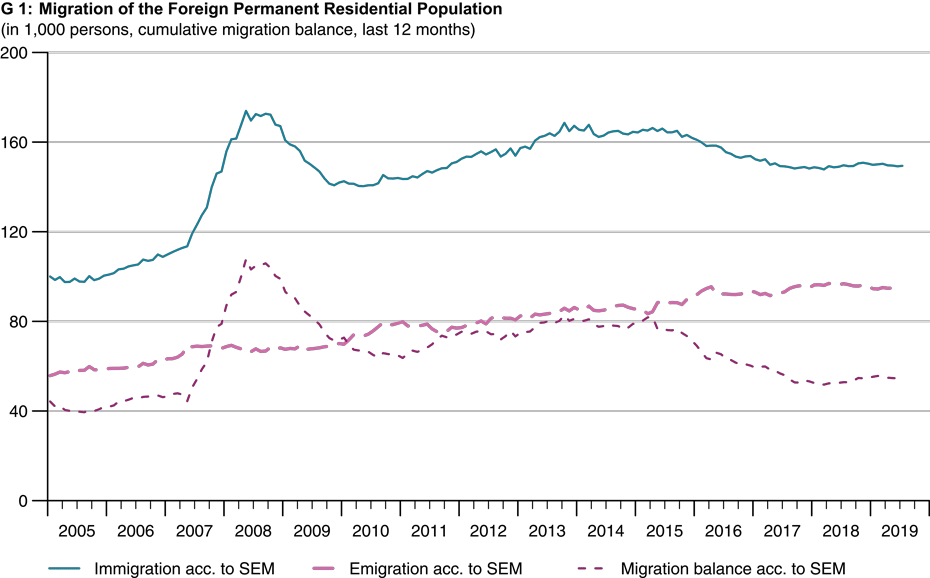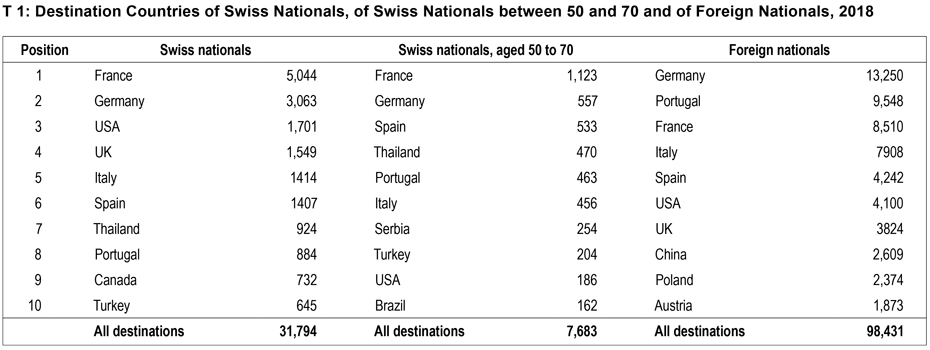Emigration at Highest Level Since Seventies – Including Swiss Nationals
- Labour Market
- KOF Bulletin
In 2018, net immigration to Switzerland hit the lowest level in twelve years. However, this is not due to lower immigration figures but to higher emigration – including Swiss nationals. In many cases, it is young people who emigrate, but numbers among 64 and 65 year-olds are also noticeably high.

Last year, Switzerland’s migration balance, i.e. the number of immigrants minus the number of emigrants, dropped to its lowest level since 2006 (see G 1). All in all, net immigration amounted to just under 40,000 persons in 2018. In the preceding year, the number of persons arriving in Switzerland was already low at 46,000. By contrast, an annual average of over 75,000 people immigrated in the period 2007 to 2016.
However, the decline of the migration balance is not due to lower immigration figures. At 170,000 immigrants, this figure remained high in 2018. Instead, it is the emigration figures that have increased steadily over the last few years. In 2018, 1.5% of the permanent resident population emigrated from Switzerland. At a total of 130,000 persons, this is roughly equivalent to the population of the city of Bern.
A quarter of the emigrants are Swiss nationals
To find similar emigration levels, one has to go back as far as the mid-seventies. It is also striking that the current emigration trend is rather broad-based. EU-28 nationals make up the highest numbers, accounting for over half (53.1%) of all emigrants. In the last few years, it was predominantly French, Portuguese and Spanish nationals who left the country.
However, less public attention is focused on the fact that emigration has also increased among Swiss nationals. Today, they make up around one quarter of total emigrants. In 2017 and 2018, approximately 32,000 Swiss nationals emigrated. This is the highest figure since 1991, the first year for which public figures are available. Hence, in these two years, 8,000 more Swiss nationals left the country than returned to it.
The most popular destination countries for Swiss emigrants were, in descending order: France, Germany, the USA, the UK, Italy and Spain (see Table 1). This trend indicates that rising numbers of Swiss nationals exercise the right to free movement of persons within the EU.
Moreover, the public figures suggest that emigration from Switzerland is based on three main motives. The most important factor is probably university studies or a job abroad. 36% of all Swiss emigrants are between 20 and 35 years of age. Secondly, people who immigrated to Switzerland in the past and are now returning to their home countries with a Swiss passport in their bags probably make up another considerable portion of Swiss emigration.
Finally, there is a surprising number of older Swiss nationals who emigrate, as shown in Table 1. In 2018, close to 30% of all Swiss emigrants were over 50 at the time of their emigration. A noticeable accumulation of emigrations can be found in the exact age groups of 64 and 65. This indicates that, after retirement, a number of Swiss nationals emigrate to spend their sunset years abroad. Given this background, it is probably no coincidence that the most popular destinations of Swiss emigrants also include exotic countries, such as Thailand and Brazil. In fact, Thailand is the fourth most popular destination among 50 to 69 year-old emigrants.
Due to population ageing, immigration is set to rise again
The decline of net immigration has a significant impact on Switzerland’s economic growth. Between 2007 and 2016, GDP growth was dominated by an over 1.1% annual population increase due to immigration. However, in the last two years, population growth rates have dropped significantly thanks to lower net immigration, declining to 0.8% in 2017 and 0.7% in 2018. This decline is almost exclusively due to lower net immigration. A permanent decrease in net immigration would affect the potential growth rate of Switzerland’s GDP, which moves almost entirely in line with the population growth rate.
However, KOF’s population scenario does not assume a permanent decline, particularly since structural demand for manpower on the Swiss labour market is set to rise in the near future: In the coming ten years, the baby boomers will depart from the labour market and Switzerland will experience a regular retirement wave. This will result in demand for replacement manpower which Swiss companies are likely to cover to a large extent with immigrants. For Swiss nationals, emigration will thus become less attractive.
More details about this topic (in German) Download KOF Analysen Autumn 2019.
Contact
KOF Konjunkturforschungsstelle
Leonhardstrasse 21
8092
Zürich
Switzerland

